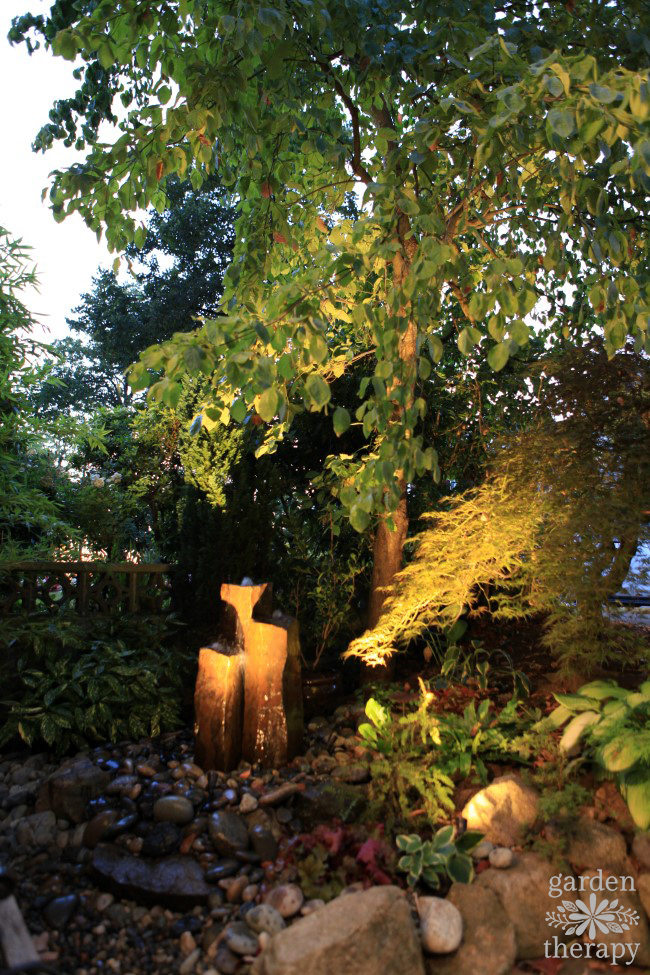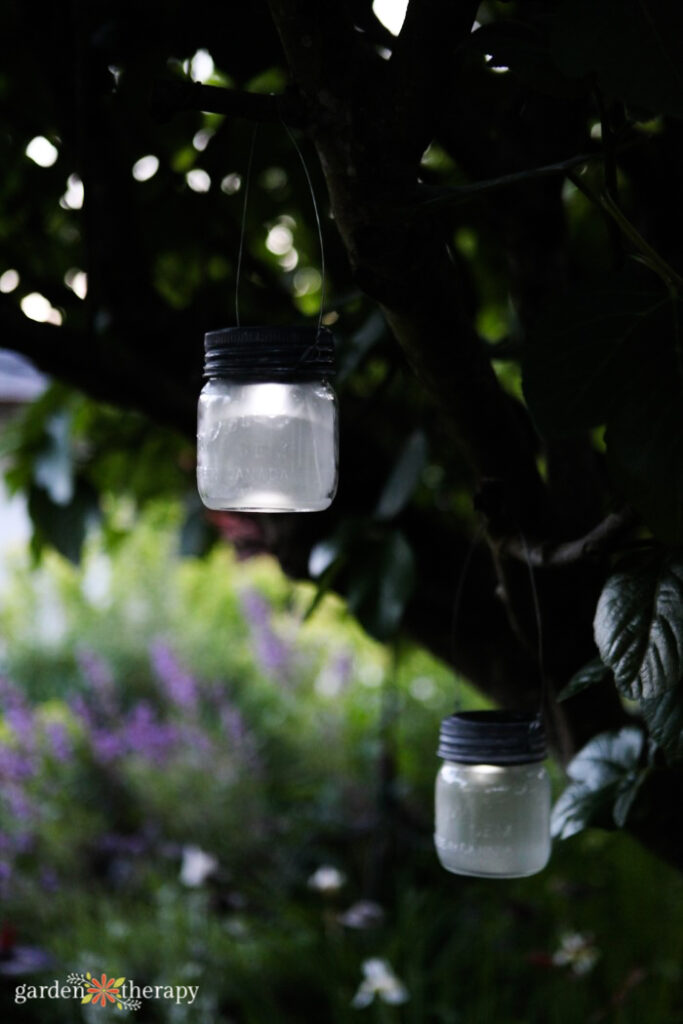Let the lunar light shine bright on your garden. Moon gardens are mystical spaces that embrace the darkness and contain bright white plants and those that only bloom at night. The result is a beautiful, serene space for enjoying the garden long after the sun has gone. Here’s how to plant your own moon garden.

When the sun sets, the garden turns into a magical place. What was once a world of bright reds and blues with buzzing bees and songbirds turns into a fairy realm where nature slows down.
While many of us and the plants, bugs, and animals head to sleep, others are just emerging for the night. They relish in the cool nights and the swell of darkness to go about their business.
Some flowers look stunning basking under a lunar glow, reflecting the moonlight and releasing sweet fragrances to attract pollinators.
If you want to experience the mystical and otherworldly feel of a moon garden, here are the plants and info you need to design one yourself!
This post will cover…
- What is a Moon Garden?
- History of Moon Gardens
- Folklore of Moon Gardening
- Gardening by the Moon
- Types of Full Moons
- Other Folklore
- Plants to Add to a Moon Garden
- How to Create a Moon Garden
- Pick a Location
- Plant Your Flowers
- Water Elements
- Landscape Lighting
- Add Seating
- More Serene Garden Designs

What is a Moon Garden?
Moon gardens are spaces specifically designed to be enjoyed at dusk and night. The flowers and plants are carefully chosen to reflect the moonlight or are plants that can only bloom once the sun sets.
Beyond the plants, other elements also make up a moon garden. The animals that come out during the day disappear, and in their place, crickets, cicadas, frogs, fireflies, moths, and bats emerge. Many of the flowers that come out at night are pollinated by moths, bats, or the wind.
Moon gardens have a distinct mystical feel to them. They’re a calming yet mysterious place where it feels like you’ve entered into a different world. If you’ve ever walked through a large garden at night, you know exactly what I mean.
Sometimes, people will refer to moon gardens as twilight, night, or evening gardens. Other times, people will use the name moon garden to describe a space with other elements like a moon gate or a window. These aren’t meant to be enjoyed at night but instead to frame a view or for spiritual purposes.

History of Moon Gardens
Moon gardens were first planted in India. The most notable is the Mehtab Bagh (moonlight garden) in the Taj Mahal complex. It has a large reflecting pool with the Taj Mahal centred in the distance. It has white walkways and many night-blooming plants.
Even before the Mehtab Bagh was built, Indians created many moon gardens. Rather than enjoy gardens on hot days, these moonlight gardens featured plants that bloomed at night. They often added pools or other water to the garden and lit pathways and platforms within it with oil lamps.
One of the first moon gardens designed in North America belonged to Benjamin Poore. In 1833, he built a moon garden in Indian Hill, Massachusetts. There, he had a large garden of white flowers and white animals, including cattle, pigeons, and a dog. White animals are by no means a moon garden requirement..that’s a Poore thing!

Folklore of Moon Gardening
The moon has long been present in many stories, myths, and folklore for people worldwide. As such a large, ethereal presence, it’s no wonder people hold the moon in such high regard.
Gardening by the Moon
Moon phase gardening, or planting by the moon, is a very old practice that believes the lunar cycle affects plant growth. While there haven’t been many studies proving or disproving this, some people still practice it.
The belief is that the moon’s gravitational pull, known to affect the earth’s tides, can also affect the water intake in plants. At a full moon, when the gravitational pull is its strongest, it pulls up lots of water from the plant roots and increases overall growth.
The phase of the moon could dictate when it was the best time to plant, cultivate, and harvest plants. Full moons allowed farmers to plant crops well into the night, especially in June when the daylight was the longest.

Types of Full Moons
Native Americans would name the types of full moons to tell time. Different areas would have different names than others, which is why we see such variety.
They were often named after what was in season. Some common ones include the Strawberry Moon in June, the Corn Moon in September, the Hunter’s Moon in October, and the Harvest Moon around the autumnal equinox.
Other Folklore
There are so many stories and old wives’ tales revolving around the moon. Here are just a few:
- Slaughtering livestock during a waxing moon results in juicier meat.
- Horseradish harvested during a full moon will have the best flavour.
- Wood shingles will lie flatter if you cut them in the moonlight.

Plants to Add to a Moon Garden
The core of a moon garden is choosing the right flowers and foliage to plant. Most often, you want night/dusk blooming flowers that come out when the sun goes down. Or, you want bright white or light-coloured flowers that will reflect the moonlight, and silvery foliage.
Other important elements are those with notable fragrances and the ability to attract pollinators.
Here are some of the most common plants you might find in a moon garden:
- Angel’s trumpet (Brugmansia) note: poisonous; keep out of the reach of pets and children
- Dahlia (Dahlia)
- Dusty miller (Jacobaea maritime)
- Evening primrose (Oenothera biennis)
- Evening rain lily (Zephyranthus drummondii)
- Flowering tobacco (Nicotiana alata)
- Foam flower (Tiarella)
- Four o’clock (Mirabilis jalapa)
- Foxglove (Digitalis purpurea)
- Gardenia augusta (Gardenia jasminodes)
- Hydrangea (Hydrangea macrophylla)
- Impatiens (Impatiens)
- Lamb’s ear (Stachys byzantine)
- Lilies (Lilium) note: poisonous; keep out of the reach of pets
- Mock orange (Philadelphus x virginalis)
- Moonflower (Ipomoea alba)
- Night blooming jasmine (Cestrum nocturnum)
- Night phlox (Zaluzianskya capensis)
- Night-scented stock (Matthiola longipetala)
- Magnolia (Magnolia)
- Peony (Paeonia)
- Snowdrop (Galanthus)
- Sweet rocket (Hesperis matronalis)
- Texas sage (Leucophyllum frutescens)
- Tuberose (Polianthes tuberosa)

How to Create a Moon Garden
Pick a Location
Place your moon garden where you’ll enjoy it the most. First things first, ensure it gets enough moonlight for the full effect of the plantings to take place. Too much shade, and you might not even notice your moon garden.
Your moon garden can be as small as a window box or as large as the entire entranceway to your house. It’s easy to mix in amongst other flowers and gardening beds, as the white will go with all the colours during the day and stand out at night.
At Moss Mountain Farm, they have a moon garden for entertaining. At dusk when the light goes down, they serve cocktails and begin their evening parties. The entire garden is white plantings that glow perfectly in the moonlight.

Plant Your Flowers
A big part of moon gardening is ensuring that you’re stimulating other senses beyond sight. Strong fragrant flowers like jasmine or gardenia can be welcome additions and attract evening pollinators.
Plant your flowers in groupings for maximum impact. Also, try to stagger the bloom times of the different plants so that your moon garden is in full effect all season long.

Water Elements
Like the original Mehtab Bagh gardens, water is another important element of moon gardening. A simple fountain can add sound and a feeling of serenity.
Still water can create stunning reflections of the moon. Try a birdbath or a pond as a reflecting pool.

Landscape Lighting
Additional ambient lighting can also be used, but sparingly. Add fairy lights to a patio or LED lights along walkways. Other great options are silhouette/spotlight lights for trees and other large windows.

Add Seating
Moon gardens are wonderful evening entertaining spaces. From late night barbeques to sitting around a backyard fire, add some seating near your moon garden. This way, you can relax and take in the mystical energy of the garden and the moon.
For extra ambience, bring along a portable speaker or add music to your moon garden.

And that’s how you can enjoy your garden by moonlight. Let me know in the comments below if you make a moon garden yourself. They really are a magical space and worth all the planning.







I’ve just built a shed near to the creek at my cottage. Intend to sit there in the evening. I was thinking about landscaping around it. This has inspired me to attempt to create a moon garden. Off to research white plants that are native to the area.
Thank you for the inspiration!
lovely!